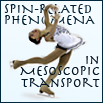Speaker
Mikhail Glazov
Description
The studies of spin phenomena in semiconductor
low-dimensional systems have grown into the spintronics –
rapidly developing area of the condensed matter physics. The
most important problems in this area are the creation of
charge carrier spin polarization and its detection, as well
as electron spin control by nonmagnetic methods, e.g.
optically. Here, we present a review of recent achievements
in the studies of spin dynamics of electrons, holes, and
their complexes in the pump-probe method. The main attention
is paid to singly charged quantum dots and to quantum wells
with low electron denisty. The microscopic mechanisms of
spin orientation of charge carriers and their complexes by
short circularly polarized optical pulses and the processes
of the spin Faraday and Kerr rotation signals formation are
analyzed. Specific features of temporal behavior of
different spin signals are addressed. Theoretical models and
experimental manifestations of the resonant spin
amplification, spin precession mode locking and nuclei
induced electron spin precession frequency focusing effects
are discussed.
Tentative plan of my talk:
1. Optical transitions in quantum dots: two-level model, transformation of electron wavefunction by the optical pulse, Rabi oscillations. Impact of selection rules: quantum disks vs. spherical nanocrystals.
2. Optical control of electron spins in quantum dots.
3. Spin Faraday, Kerr and ellipticity effects in quantum dots. Role of ensemble inhomogeneity.
4. Electron spin precession in the external magnetic field.
5. Spin accumulation caused by the train of pump pulses. Resonant spin amplification and mode-locking of electron spin coherence. Nuclei-induced electron spin precession frequency focusing.
References:
[1] M.M. Glazov, Coherent spin dynamics of electrons and excitons in nanostructures (a review), Physics of the Solid State 54, 1 (2012).
[2] I.A. Yugova, M.M. Glazov, E.L. Ivchenko, and Al.L. Efros, Pump-probe Faraday rotation and ellipticity in an ensemble of singly charged quantum dots, Phys. Rev. B 80, 104436 (2009).
[3] A. Greilich, D.R. Yakovlev, A. Shabaev, Al.L. Efros, I.A. Yugova, R. Oulton, V. Stavarache, D. Reuter, A. Wieck, and M. Bayer, Mode Locking of Electron Spin Coherences in Singly Charged Quantum Dots, Science 313, 341 (2006).
[4] M.M. Glazov, I.A. Yugova, S. Spatzek, A. Schwan, S. Varwig, D.R. Yakovlev, D. Reuter, A.D. Wieck, and M. Bayer, Effect of pump-probe detuning on the Faraday rotation and ellipticity signals of mode-locked spins in (In,Ga)As/GaAs quantum dots, Phys. Rev. B 82, 155325 (2010).
[5] A. Greilich, Sophia E. Economou, S. Spatzek, D.R. Yakovlev, D. Reuter, A.D. Wieck, T.L. Reinecke, and M. Bayer, Ultrafast optical rotations of electron spins in quantum dots, Nat. Phys. 5, 262 (2009).
[6] A. Greilich, A. Shabaev, D.R. Yakovlev, Al.L. Efros, I.A. Yugova, D. Reuter, A.D. Wieck, and M. Bayer, Nuclei-Induced Frequency Focusing of Electron Spin Coherence, Science 317, 1896 (2007).
[7] M. M. Glazov, I. A. Yugova, and Al. L. Efros, Electron spin synchronization induced by optical nuclear magnetic resonance feedback, Phys. Rev. B 85, 041303(R) (2012).
Tentative plan of my talk:
1. Optical transitions in quantum dots: two-level model, transformation of electron wavefunction by the optical pulse, Rabi oscillations. Impact of selection rules: quantum disks vs. spherical nanocrystals.
2. Optical control of electron spins in quantum dots.
3. Spin Faraday, Kerr and ellipticity effects in quantum dots. Role of ensemble inhomogeneity.
4. Electron spin precession in the external magnetic field.
5. Spin accumulation caused by the train of pump pulses. Resonant spin amplification and mode-locking of electron spin coherence. Nuclei-induced electron spin precession frequency focusing.
References:
[1] M.M. Glazov, Coherent spin dynamics of electrons and excitons in nanostructures (a review), Physics of the Solid State 54, 1 (2012).
[2] I.A. Yugova, M.M. Glazov, E.L. Ivchenko, and Al.L. Efros, Pump-probe Faraday rotation and ellipticity in an ensemble of singly charged quantum dots, Phys. Rev. B 80, 104436 (2009).
[3] A. Greilich, D.R. Yakovlev, A. Shabaev, Al.L. Efros, I.A. Yugova, R. Oulton, V. Stavarache, D. Reuter, A. Wieck, and M. Bayer, Mode Locking of Electron Spin Coherences in Singly Charged Quantum Dots, Science 313, 341 (2006).
[4] M.M. Glazov, I.A. Yugova, S. Spatzek, A. Schwan, S. Varwig, D.R. Yakovlev, D. Reuter, A.D. Wieck, and M. Bayer, Effect of pump-probe detuning on the Faraday rotation and ellipticity signals of mode-locked spins in (In,Ga)As/GaAs quantum dots, Phys. Rev. B 82, 155325 (2010).
[5] A. Greilich, Sophia E. Economou, S. Spatzek, D.R. Yakovlev, D. Reuter, A.D. Wieck, T.L. Reinecke, and M. Bayer, Ultrafast optical rotations of electron spins in quantum dots, Nat. Phys. 5, 262 (2009).
[6] A. Greilich, A. Shabaev, D.R. Yakovlev, Al.L. Efros, I.A. Yugova, D. Reuter, A.D. Wieck, and M. Bayer, Nuclei-Induced Frequency Focusing of Electron Spin Coherence, Science 317, 1896 (2007).
[7] M. M. Glazov, I. A. Yugova, and Al. L. Efros, Electron spin synchronization induced by optical nuclear magnetic resonance feedback, Phys. Rev. B 85, 041303(R) (2012).

